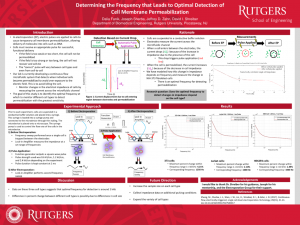Fanik, Dalia: Determining the Frequency that Leads to Optimal Detection of Cell Membrane Permeabilization
Title: Determining the Frequency that Leads to Optimal Detection of Cell Membrane Permeabilization
Name: Dalia Fanik
Major: Biomedical Engineering
School affiliation: School of Engineering
Programs: Aresty – Research or Conference Funding Recipient
Other contributors: Joseph Sherba, Dr. Jeffrey D. Zahn, and Dr. David I. Shreiber
Abstract: In electroporation (EP), electric pulses are applied to cells to cause temporary cell membrane permeabilization. The goal is to apply an electric pulse that will ensure both molecular delivery and cell viability. The applied electric field must be optimized because an electric field that is too weak may not permeabilize the cell membrane enough to enable delivery, whereas a field that is too strong will kill the cell. Our lab is developing a microfluidic system that can detect permeabilization of individual cells. It is important to detect permeabilization of individual cells because that signals to turn off the electric fields, which avoids over-exposing the cells to the electric field. Over-exposing cells to a strong electric field will kill the cells. Detection of cell membrane permeabilization is done by monitoring the impedance of the cell membrane, where changes in impedance due to permeabilization will differ with frequency. After EP, the impedance drops, indicating cell membrane permeabilization. The goal of this study is to identify the frequency at which to monitor the changes in impedance for different cell types to detect permeabilization with the greatest sensitivity. Materials and Methods: Three different cell types will be used: NIH 3T3 fibroblasts, HEK293 cells, and Jurkat cells. Cells are suspended in buffer solution and placed into a syringe pump (Harvard Apparatus, Massachusetts) that is connected to the microdevice. The microdevice contains the planar electrodes that are used to detect cell permeabilization. Using the syringe pump to control the flow rate, cells flow through the microdevice until a cell is trapped between the electrodes. A lock-in amplifier (Zurich Instruments, Switzerland) is used to measure the impedance of the cell membrane at frequencies ranging from 0-100 kHz. The cell is then electropermeabilized with a field strength of 0.6 kV/cm, 1.2 kV/cm, and 2.4 kV/cm applied for 1 ms, and the impedance is measured again. The pre-EP and post-EP impedance measurements are then compared to identify the frequency range with the most sensitivity. Results and Discussion: Preliminary data collected on 3 cell types suggests that the optimal frequency for detection is around 1 kHz.
